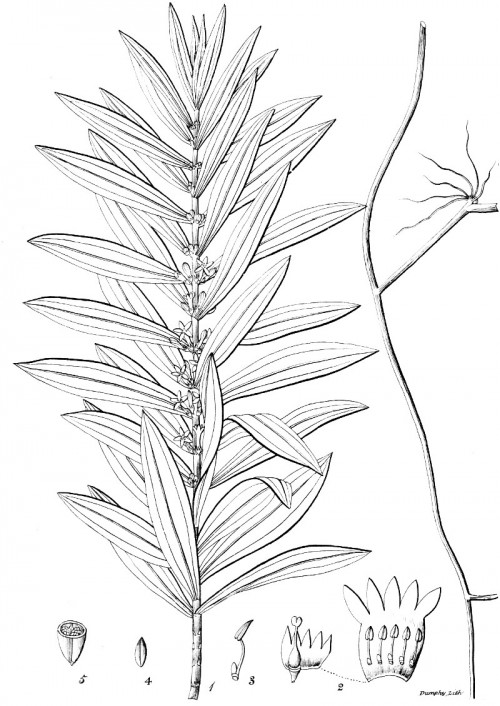Enicostema axillare (Lam.) A. Raynal - syn.Gentiana axillaris Lam.; Adenema hyssopifolium (Willd.) G. Don. - Gentianaceae
Enicostema axillare subsp. littorale (Blume) A. Raynal) = Enicostema littorale Blume
mamejava, chhota chirayta, Indian Gentian
Erect perennial herb, up to 30cm high, native to tropical Africa, India, Southeast Asia and Malaysia; leaves linear to lanceolate or narrowly oblong, entire; flowers white with green lines, drying yellowish, sessile or subsessile.
http://gentian.rutgers.edu/species/sp_Enic_lito%20herbal.htm
„Enicostemma littorale (Gentianaceae) is one of the several herbs mentioned for the treatment of diabetes mellitus. It is known as Nagajihva or Mamejava in Ayurveda…
From our lab we have reported, the aqueous extract of E. littorale and its n-butanol and ethyl acetate fraction were reported for its antidiabetic effect. Vishwakarma et al., suggested that the active compound(s) of these effects might be present in these fractions and swertiamarin was one of the major components of these two fractions. Based on this rationale we have decided to evaluate swertiamarin for hypolipidemic effect…
Serum total cholesterol/HDL ratio was significantly lowered in the swertiamarin and atorvastatin supplemented groups than in the high cholesterol fed group due to a decrease in the total cholesterol synthesis and/or increases metabolism of the total cholesterol. Consequently, the atherogenic index was also lowered significantly by the swertiamarin and atorvastatin treated groups.“
[Swertiamarin: A lead from Enicostemma littorale Blume. for anti-hyperlipidaemic effect, Hitesh Vaidya, Mandapati Rajani, Vasudevan Sudarsanam, Harish Padh, Ramesh Goyal, European Journal of Pharmacology 617 (2009) 108–112]
Swertiamarine content of methanolic extracts of E. littorale (whole plant) samples from three regions of India was found to be 7.1-11.7%.
[Estimation of Swertiamarin in Enicostemma Littorale and Marketed Formulations Using HPLC-UV Method, Prawez Alam1, Mohammad Ali, Rahul Singh, Faiyaz Shakeel, J Bioanal Biomed 1, 2009, 22-27]
http://omicsonline.org/ArchiveJBABM/2009/December/03/JBABM1.22.php
„Many traditional Indian medicinal plants which contain large quantity of a secoiridoid, swertiamarin are being used to relieve pain. Iridoids present in a wide variety of medicinal plants possess a large number of medicinal properties. In the present study in vivo antinociceptive activity of swertiamarin isolated from E. axillare was carried out using three different methods in mice. In the hot plate method, a significant increase in the latency period was observed for the treatment with swertiamarin at 100 and 200 mg/kg bw after 30 and 45 min. The percent protection observed after 45 min was 109.42, 147.42 and 157.14, respectively, for the standard paracetamol and swertiamarin at 100 and 200 mg/kg bw treatments. A significant increase in the tail withdrawal reflex was observed for the swertiamarin treatment at both the doses with percent protections of 150 and 200, respectively. In both these methods, swertiamarin produced potent activity than that of standard paracetamol. In the acetic acid induced writhing, swertiamarin at 100 and 200 mg/kg bw reduced the number of writhes significantly. Dose dependent results were observed in all the three methods and among the two doses, swertiamarin at 200 mg/kg bw showed potent activity. These results prove that swertiamarin possess both peripheral and central antinociceptive activity.“
[Antinociceptive activity of swertiamarin isolated from Enicostemma axillare., Jaishree, V., Badami, S., Kumar, M.R., Tamizhmani, T., Phytomedicine, Vol.16(2), 2009, 227-232]
„Swertiamarin treatment had no significant effect on adipogenesis, or the mRNA expression of PPAR-γ and GLUT-4; however, there was a significant increase in the mRNA expression of adiponectin. On the other hand, treatment with gentianine significantly increased adipogenesis, which was associated with a significant increase in the mRNA expression of PPAR-γ, GLUT-4 and adiponectin. These findings suggest, for the first time, that the anti-diabetic effect of swertiamarin is due to gentianine, an active metabolite of swertiamarin.“
[Anti‐diabetic Activity of Swertiamarin is due to an Active Metabolite, Gentianine, that Upregulates PPAR‐γ Gene Expression in 3T3‐L1 cells., Vaidya, H., Goyal, R.K., Cheema, S.K., Phytotherapy Research, Vol.27(4), 2013, 624-627]

Enicostema axillare (Poiret ex Lam.) A.Raynal [as Adenema hyssopifolium G. Don]
Wight, R., Icones Plantarum Indiae Orientalis, vol.2(1), t.600 (1846) [n.a.]
http://plantgenera.org/species.php?id_species=383938
